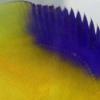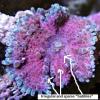-
Posts
16,553 -
Joined
-
Last visited
-
Days Won
29
Content Type
Profiles
Forums
Gallery
Everything posted by yikai
-
Next in the family, anthelias. Known as waving hands Looks very similar to xenias and one of the most often confused out of all. Grows in mats, with no stems. Long polyps attached to a creeping mat, rather similar to star polyps. Polyps are non-retractile or semi-retractible. Most species do not pulse or pulse by curling, not in the open-close fashion. notice the creeping fashion in which it grows, not propt up by stems
-
Xenias and other similar looking corals are one of the most poorly identified corals. Many species of corals look similar and most people just lump them together and call them "xenias". This thread should help future IDs and clear the air! Firstly, the genus Xenia, belongs to the higher family, xeniidae. Xenias are famed for their pulsating abilities. 5 petaled polyps found on stalks that congregate only at the apex of a stem. Xenias have tall or short stems which differentiates them from others in the family. Consists of a few species, the most famous being Xenia elongata, and xenia umbellata (fastest pulsing and largest polyped of all the xenias) here's a close up view of polyps belonging to X. umbellata. Notice the large clove like polyps! 2nd picture shows xenia elongata with typical appearance. 5-petaled polyps, on stalks, attached to a large central stem.
-
rockscape is exquisite! You have an artistic eye my friend
-

Wanting to Start a Nano Reef Tank!
yikai replied to AloysiusMun's topic in New to the Marine Aquaria Hobby
-
hehehehe :superman: good for them to be exposed to everything from equipment, livestock, and different ways of reefkeeping. i myself have tried some unorthodox methods before and it worked to my advantage but i think not as pro as yours LOL! kk dont off topic.
-
no problem all fairy wrasses are born females. They live in harems in the wild, consisting of numerous females, a few transitioning males and one alpha male. The alpha male will control and guard his harem from other wrasses, and flash to display at them during courtship. when the alpha male dies, either the transitioning males will morph to take it's place, or one of the dominant females will begin morphing into a male, and then to an alpha male. This information is very important if you wish to recreate the haremic community in your tank.
-
thread moved to the correct section. will drop by to share my part on livestock selection, requirements and chide in on some equipment FAQ.
-

Wanting to Start a Nano Reef Tank!
yikai replied to AloysiusMun's topic in New to the Marine Aquaria Hobby
feel free to approach me regarding any of the advise i gave you if you don't understand or need more clarification, or just post here for others to help! -
no. that's a male flame wrasse. it's a beautiful specimen but not yet to the alpha terminal male standard. male and female flame wrasses are differentiated by a few things. All fairy wrasses are sexually dichromatic and dimorphic, meaning can be differentiated by colour and size. males have yellow on the body and the 2 obvious red stripes on the eyes. females are just a uniform pinky-orange. compare the below photos.
-
i hope you appreciate the above two posts because i SPILLED MY ROJAK ON MY CARPETED FLOOR WHILE DOING IT!
-
-
that's some really nice and big liverock!
-
hola! una cálida bienvenida a mi amigo! tanque Bueatiful y tus corales son increíbles! Espero que disfruten su estancia aquí y no dude en hacer cualquier pregunta haha. pardon my spanish (: a warm welcome my friend.
-
yumas have irregularly shapes bubbles and bumps. giving it a rough, warty lookign surface. rics have smooth round and somewhat similar shaped bumps. the bubbles and bumps are very tightly spaced giving it a very "bunch of grapes" look. also, rics never appear in any other shipment except carribean.
-

Setting up marine tank - need help.
yikai replied to kksg2000's topic in New to the Marine Aquaria Hobby
errm, threadstarter. don't waste money using saltmix to put water in your tank BEFORE cycling. it doesn't matter if u use NSW or salt mix. during cycling, tons of parameters are going to swing together with huge ammonia spikes, nitrite spikes and nitrate spikes. at this point, doesn't matter if u use salt mix or NSW. use NSW since it's cheaper just use NSW as it is cheaper than using saltmix for the entire tank. however, after cycling, subsequent water changes, salt mix will be best. -
captive bred latz clowns have been regularly available on LA's diver's den. they aren't as popular as the others and usually stays there for a couple days before being sold.
-
please resize your pictures in future.. it will be much easier for us to view. ups for your sales.
-

Setting up marine tank - need help.
yikai replied to kksg2000's topic in New to the Marine Aquaria Hobby
pump outlet > chiller inlet > water gets cooled in your chiller > cooled water flows out of chiller outlet > from outlet to sump tank or main tank. don't connect the outlet to another pump. -

Setting up marine tank - need help.
yikai replied to kksg2000's topic in New to the Marine Aquaria Hobby
my honest opinion, i would recommend a simple standard 3ft set up for new reefers. this is a very good size for budding aquarist as the water volume is large enough to accommodate errors. a tank of 3ft will ensure rather stable parameters compared to a nano tank of say 1ft+. This includes fluctuations of salinity, temperate etc. small tank = small water volume = small room for errors. larger tank = larger water volume = large room for errors. a small tank requires more care and attention and higher chance of something going wrong. the smaller water volume means a smaller dilution factor and things go wrong faster. for a new aquarist, this can spell disaster. 3ft is not too large nor too small. IMO, a perfect size. if you're worried about pricing, it's not very expensive if you go for normal standard set up. the difference in pricing will allow you tons more space for livestock, errors, experimenting and fun! definitely worth it IMO. if price is still a concern, 3ft tanks are rather easy to find 2nd hand from dealers in pasar malam thread. as 3ft is a rather popular tank size. however if you still insist in getting a smaller tank, then make sure you put in the extra effort to maintain the parameters. Remember when it comes to marine tanks, bigger is better. In terms of stability larger tank (compared to a small one) pros - allows room for fish to grow, and more livestock to be added - dilute coral allelopathy (chemical warfare) - reduce aggression - lower salinity swings - lower parameter fluctuations - organics won't rise as fast - wider range of livestock kept - *if you opt for a sumptank, extra water volume, more equipment can be added, space for future projects (refugium etc) cons - large amount of space - the larger it is, the harder to do physical maintenance (water change, scrubbing etc) - difficult placement corals, rocks - more expensive to run (electricity bills etc) of course there are many more pros and cons, and the idea of a larger/smaller tank is purely subjective and based on one's individual preference. i thought since most of the posts here are geared towards smaller tank, i'll just give you another alternative should you decide on either. whatever your choice, hope you prosper in your hobby, and a warm welcome to SRC. -
if 1 ricordea (yuma or florida) has only one mouth, cut through the middle of the mouth and both halves will heal into a full ricordea. in the event you miss the middle of the mouth, and end up with a full mouth on one frag and the other frag without a mouth, the other frag will/might heal and grow a new mouth (as what terryz has mentioned)
-
just curious. anyway thread closed as requested
-
ricordea florida usually come attached to small stones or unattached. to frag it, just cut it in half and let it heal. you may need to glue it on the rock after it heals, or let it naturally attach itself (which may take quite long). if not fragging, just stick the small stone to wherever you wanna place it. they are expensive because they come from carribean =.=
-
lcf425, this is a good article on the genus Ricordea, which includes detailed information on the two species. R. florida and R.yuma.











